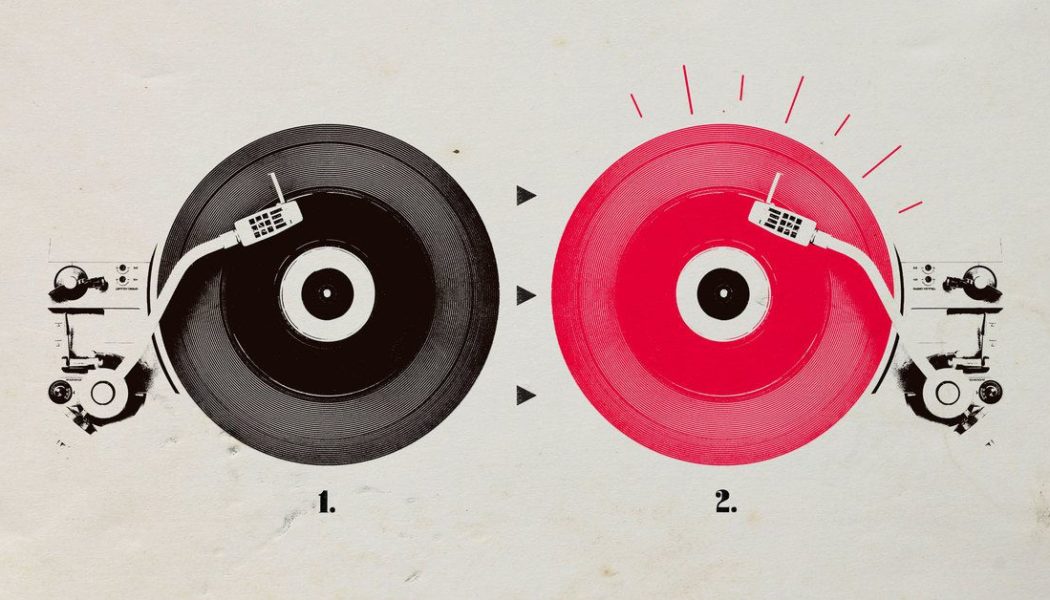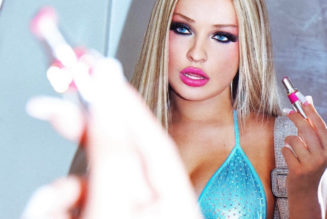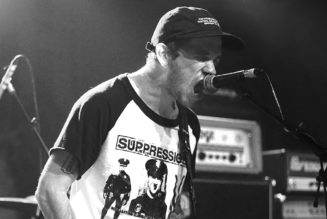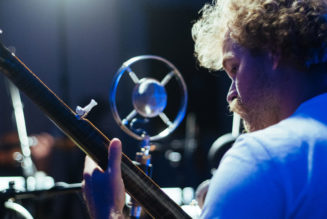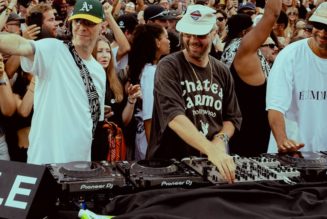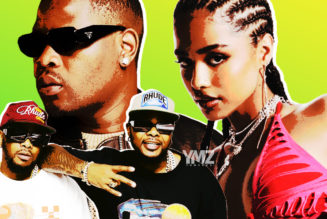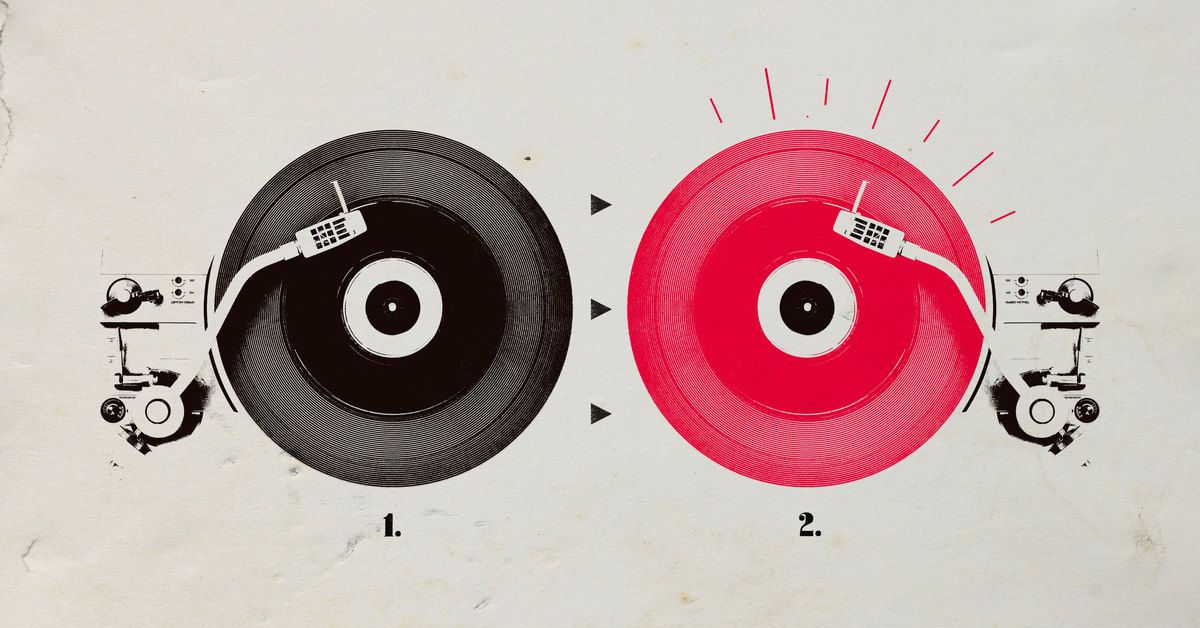
Brendan Brown sits in front of about 20 small neon-orange rectangles, stacked neatly in rows of three and four. “That’s 0.05 percent of the hard drives that I have in my life,” the Wheatus frontman says proudly. To Brown, the drives are more than just terabytes of storage. They represent one of the most grueling yet gratifying endeavors of his band’s career: the rerecording of the entirety of their 2000 self-titled debut, a painstaking process in the name of owning their own music. Like many artists, Brown had become impatient with a copyright system that put his creative output in the control of a corporation that dropped Wheatus almost two decades ago. Keeping his rerecorded masters within arm’s reach might seem like overkill, but after years of radio silence from his previous label, Sony, on the whereabouts of Wheatus’s original master tapes, he isn’t taking any chances. “I keep the masters in my presence, because nobody’s getting them again,” he says.
When Taylor Swift announced in 2019 that she planned to rerecord her first six albums, which were released by Big Machine Records, after Big Machine’s catalog was sold to Scooter Braun’s Ithaca Holdings (and later to the investment firm Shamrock), she became a megaphone for artists across genres who had been fighting for decades for a bigger cut of the economic pie. “She has become a spokesperson for artists’ rights and, in particular, drawn awareness to the perceived unfairness,” says Duke University law professor Jennifer Jenkins, who specializes in intellectual property.
While the scale of Swift’s efforts surpasses similar endeavors from other musicians—Speak Now (Taylor’s Version), released this past Friday, marks the halfway point of her ambitious rerecording project—she’s far from the first artist to return to the studio in search of financial and creative freedom. In 2010, U.K. new wavers Squeeze released Spot the Difference, an album of song rerecordings from across their catalog, in order to own the copyrights to their biggest hits. Blondie’s 2014 compilation album, Blondie 4(0)-Ever, similarly includes rerecordings partially as a way to cash in on so-called “sync” requests, where studios pay to use a song for film, television, and advertisements. JoJo rerecorded her first two albums in 2018 after leaving a contentious deal she signed as a minor with Blackground Records. “I lost agency over my own career and my history,” she told Billboard at the time. “Rerecording these songs reminded me of the path that I was on with my first album.” But Swift’s outsized impact on rerecording is hard to deny. “The fact that you and I are talking about this just shows how much attention that she has successfully drawn to this,” Jenkins says.
Whether artists are directly inspired by Swift’s endeavor, rerecord to facilitate sample clearances, or simply want more creative control over their music, more musicians are betting on rerecording as a lucrative path toward ownership of their masters. But why do these artists need to rerecord their own music? Shouldn’t the originality of their lyrics and composition be enough to claim some rights? “One of the unusual things about any piece of recorded music is that there [are] those two rights for a single piece of recorded music,” Jenkins says. For every song protected under copyright, there is a publishing right, referred to in legal terms as “circle C,” which covers lyrics, musical composition, and anything else about a song that could be represented on a page. In addition, since 1971, when the U.S. extended copyright protections to sound recordings, songs have also been granted a “circle P” right to cover the song’s recording; this is what we typically refer to as a song’s “master.”
Those “circle P” rights are what artists are trying to earn back by rerecording their music. Without them, they’re limited in the ways they can use their music—remixes, a cappella versions, radio mixes, and anything else that would be a manipulation of the song’s recording, not to mention the original song itself. For many musicians, their publishing rights and master rights are owned by the same entity, typically a record label. But that’s not always the case. When Wheatus signed to Sony/Columbia, Brown leveraged two deals based on advice he received in previous band experiences: “EMI and Sony were competitors. EMI had our publishing. Sony had our masters. That was a trick they taught me in the ’90s through the other acts: Never sign your publishing to the same label as your master, because they’ll do their own books, which is no good.” Because EMI had the band’s publishing, Wheatus could deal separately with that label for licenses that fell under “circle C” rights, such as covers of the song.
While the boilerplate language for standard contracts typically leaves the artist without much recourse—“Most of the time, that lasts for 75 years, designed to outlast the life of the artist, basically,” Brown says—music licensing can be even messier with insufficient contractual language, as demonstrated by the long saga to bring De La Soul’s music to streaming. The Long Island hip-hop trio was famous for its pioneering use of samples, but paperwork from the group’s label, Tommy Boy, was flimsy. “Sampling was new, especially for their very first album. The rules were just different,” Michelle Bayer, who administers De La Soul’s publishing, tells The Ringer. “Even at the major labels, the language was very specific to LP, cassette, and CD. That’s how it was worded. There was no thought of streaming or digital downloads or anything like that; the language didn’t exist.”
Because De La Soul’s contracts likely didn’t include one key phrase that is now standard in music contracts—“in all media now known and hereafter devised”—their music and its samples had to be re-cleared for modern music technologies. When they couldn’t clear all the samples, De La Soul had to make a difficult choice. “They had to make the decision to either not include the song, which would make the album incomplete, or do some manipulation—drop out that horn or replay that drum line that they could not get cleared from a different master sample,” Bayer says. The group used rerecordings, helmed by Prince Paul and Scott “Scotty Hard” Harding, who both worked on their original albums, to facilitate clearance for sounds from song snippets that they could not clear.
Even if artists knew what they were signing away when they joined a label, they didn’t exactly have a choice about who owned their masters in the traditional music business model. “Artists typically don’t have a lot of negotiating leverage, because back then, if you wanted to get your song recorded on a physical format and out there so that anybody would ever hear it, you would want to sign that contract,” Jenkins says. The traditional contract model accounts for the risk labels take on by signing new acts, many of whom never go on to become, say, Taylor Swift. “They’re putting in the money up front, the advance to make the album, money to make the music, video, etc. Contracts are drafted this way in order to make that economically feasible.” Even bands who had the capacity to self-record, like Wheatus, who recorded their entire debut album in Brown’s mother’s basement in Long Island, still relied on the traditional label model for success. “There was no internet to drop your music on,” Brown says. “There was no YouTube. There was no direct distribution to iTunes or Apple Music. There was no such thing as Spotify. Now, people like Fugazi and Ani DiFranco and Jandek would argue that there was always an avenue for releasing, but the opportunity for self-distribution wasn’t really there to contemplate in the way that it is now.”
Modern recording and distribution technology has upended many of the power dynamics on which those original label contracts were founded. “Because of the internet, artists can actually sidestep the major label system,” Jenkins says. “On my computer here, if I wanted to record a song and I had any talent at all, I have a recording studio right there, and I could put my song up on a streaming service.” Services like DistroKid and CD Baby, which allow independent artists to upload their songs on Apple Music, Spotify, and other streaming services, are growing in popularity each year. In 2021, DistroKid said that it processed more than 35,000 songs a day, compared with a Spotify total of more than 60,000 a day from that same year. And while the number of independent artists earning over $10,000 annually on Spotify dipped from 2021 to 2022 according to Spotify’s own Loud & Clear data, the 14,700 who did generate more than that made up a quarter of all artists who earned at least that much on the platform. (Spotify is the parent company of The Ringer.)
For Alex Greenwald, the lead singer of Phantom Planet, the decision to sign a contract with Epic made sense when they joined the label ahead of their sophomore album, 2002’s The Guest. “Some of us were 19 and 20 when we signed that contract. At that age, you’re signed to a label, and they give you some extra cred that you’re doing the right thing as a musician,” Greenwald says. “[Ownership of our masters] was just something we chose not to negotiate because no one really did that.” When one song off that record, “California,” became the opening music for one of the biggest teen dramas of the decade, the band thought they had made it. “All bands are trying to buy tickets to win a lottery like that, and we kind of won,” he says. It was 20 years down the line when he began to see things differently. “They’ve really owned the recordings for a long time, and they’re still in control of decisions that we want to make. They’re not our label anymore, and yet they still own our stuff.” Rerecording was one of the options he used to take ownership of his band’s music.
There’s a reason more artists aren’t rerecording their songs, Taylor style. It’s an intensive process, one that can be even more grueling than the original days or weeks spent in the studio. There’s also the risk that the newer versions will come off as weaker imitations of the originals. “People who have bonded with the original version feel like there’s some uncanny valley being crossed, or there’s some faker that may be causing the experience of feeling the song to change,” Greenwald says. When the band decided to record “California” again, they took care to ensure that much of the original recording’s ambience remained the same. “We went back to [L.A. recording studio] the Sound Factory, the same room we recorded [the original version] in. We used the same mics, save for when it came to vocals, but it’s still run through the same effects chain that the original [was],” Greenwald says. All members, except for former drummer Jason Schwartzman, were involved (Schwartzman was busy filming Asteroid City). The original recording, helmed by Mitchell Froom and Tchad Blake, also made use of some proprietary recording techniques, which the band sought out for their rerecording. Blake used a device called a binaural microphone to record “California.” “It looks like an impaled robot head,” Greenwald says. “We used that same binaural head for the rerecording. We tried to get it exactly how we recorded originally.” Still, the process took days of overdubbing, as the band listened back and discovered sounds that were missing from their new version. “When we listened to the original and A/B’d it with the new one, there were certain instruments that we forgot. There’s an organ sound in the solo section that Mitchell played, so none of us had the memory of playing it.” Close listens of the new recording reveal small differences in Greenwald’s vocals compared to the original recording, but their instrumentals are uncannily similar, with their 2023 version matching the original’s mix of euphoric guitar swells and contemplative piano.
Because De La Soul needed to rerecord only small segments of sounds to replace samples they couldn’t clear, it was extremely important to them that those new recordings wouldn’t sound out of place next to rap tracks that were more than 30 years old. “The last thing that the group wanted was for this to sound like a 2023 recording,” Bayer says. “One of the reasons that they went to Scott [Harding]’s studio is that Scott had all the original equipment from the original studio that they recorded in. And so anything that they did have to redo was done on equipment from the 1980s.” Harding, who was a frequent collaborator with De La Soul and other artists who came through the legendary Calliope Studios, elaborated: “I own the original drum machine from Calliope that these records were made with, so I had that set up, and I had an Akai S950 set up.”
When Prince Paul came to Harding with the rerecording project, he initially asked if they could complete it in a month, an idea Harding rejected outright. The process of reconstructing De La Soul’s music was intensive and tedious because of the group’s production techniques: “Every song that you hear had every drum loop going from the beginning to the end, every bass loop going from the beginning to the end, every keyboard loop going from the beginning to the end. And then it was all arranged in the mix,” Harding explained. After determining how the loops played into the song’s final mix, Harding and Paul worked with artists across the country—some in Harding’s studio, some who shared recordings virtually—to replicate specific samples. Harding remixed every De La Soul song, even those that didn’t need additional clearances, so that the group would own the masters necessary to create other alternate mixes from their music. Those versions aren’t shared with the public, but “the intention was to generate instrumental versions of all the songs so that they could more easily license things,” Harding says.
While some musicians could easily locate the physical equipment used to record their first masters, others struggled to even find their original tapes. Such was the case with Wheatus, who gave all of their physical multitracks to Sony and never saw them again. “We worked so hard to create that record. We developed our own techniques,” Brown says of the original recordings. “It felt so weird and wrong that that wouldn’t exist anymore. Our hard work in the individual tracks, the way that the kick drums sounded, the different formulas that went into the recipe that we concocted had disappeared because the document of them was gone.”
To attempt the Wheatus rerecording, Brown brought a tape of the band’s penultimate recording session—tracked on an obsolete ADAT format—to a now-closed studio called Dreamhire in Long Island City around 2013 or 2014. Luckily, Dreamhire was able to upload 60 to 90 percent of certain songs into Pro Tools, which allowed them to build a skeleton for the recording. “We were able to recreate this penultimate session and replace one instrument at a time. That was very fortunate, because starting from full scratch, we still wouldn’t be done.” In addition to playing on the same instruments that the band used for the original recording, Brown also recorded the album in a basement, albeit one in the Bronx, not in his mother’s house. “We had that same ethos in the approach,” he added. But his woes didn’t end once the songs were restored: After their release, Sony quickly flagged them for copyright infringement on YouTube, claiming they were the original recordings. “We had to take about five weeks with a lawyer going back and forth with them,” Brown says. “I had to provide proof that the multitracks are not the same length.”
For Taylor Swift, the rerecordings have been extremely lucrative: The Taylor’s Versions of both Red and Fearless have outpaced their original counterparts tenfold in streams since their respective releases. (This is in addition to any profit she generates from her songs’ publishing copyright, which she holds even for music released in her Big Machine era.) The new recordings also resulted in their own breakout single, “All Too Well (10 Minute Version) (Taylor’s Version).” With Swift’s promotion of the anti–Big Machine narrative and the devotion of her fan base, rerecordings have become canon. For artists without such reach, success with rerecordings looks a little different. The reception to Wheatus’s rerecordings has been “better than expected,” Brown says. “We’ve licensed it several times in film and streaming services, television shows and things. It’s very easy to do with us because you just reach out to us on our website.” “Teenage Dirtbag (2020),” the band’s rerecorded version of their biggest hit, has racked up an impressive 8.5 million Spotify streams since its release. It still trails the original’s half a billion streams, but there is one silver lining—it’s beating the sped-up version that their old label released, likely to increase the song’s virality on platforms like TikTok.
Phantom Planet’s rerecording was released this past May, and while Greenwald doesn’t know the exact number of streams for the song, he still thinks the reception has been “fantastic for something that we just put out that we self-released that we only told our Instagram account about.” And of course, De La Soul’s catalog was celebrated when it came to streaming earlier this year. That doesn’t stop fans from calling out the parts they think were rerecorded, though. “Paul and I got interviewed by somebody from Wax Poetics magazine, and he was like, ‘Yo, this guy told me that “Ring Ring Ring” has a replay in it,’” Harding says. “Paul and I just laughed. And I said, ‘I’ll tell you for sure that one had no replays in it.’”
While Brown notes that rerecordings aren’t exactly an artist’s dream—“The most anti-creative thing you can possibly do is try and go back to figure out how you did something creative in the first place,” he says—the songs felt familiar, as his band has been touring extensively to help fund his efforts in the studio. Beyond the financial success of rerecordings, the artists I spoke with also discussed something more profound about returning to the studio to revisit the songs that made them huge. “It also goes back to the early days of Calliope,” Harding says. “We all came out of that little studio, and we’re all still making records 30 years later.” The studio experience felt nostalgic for Greenwald: “It’s a nice feeling to know you have ultimate control over something, and you’ve done your creative work. Rerecording it brought back so many memories of originally recording it. It unlocked these little things that would just pop off in my brain, which was really nice.” For Brown, the experience left him with a hard-earned lesson: “Never give away your publishing or your masters. Now that you really can [control recording and distribution], there’s no excuse not to hoard your shit and keep it under your bed.”
Arielle Gordon is a writer and software engineer based in Brooklyn. Her work can be found at Pitchfork, Bandcamp, Stereogum, and on her grandmother’s fridge.
